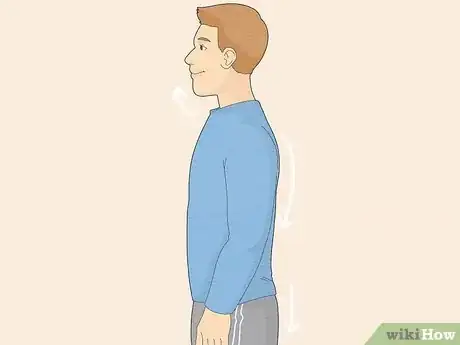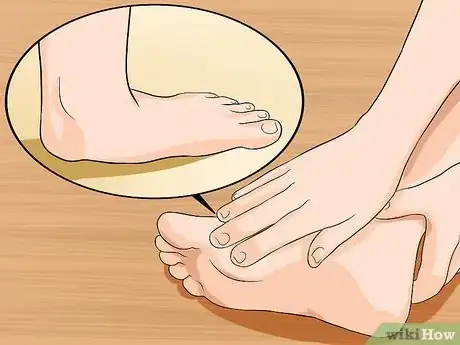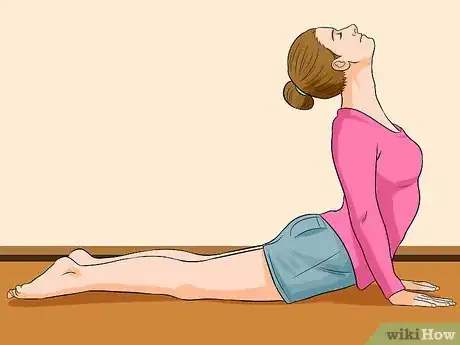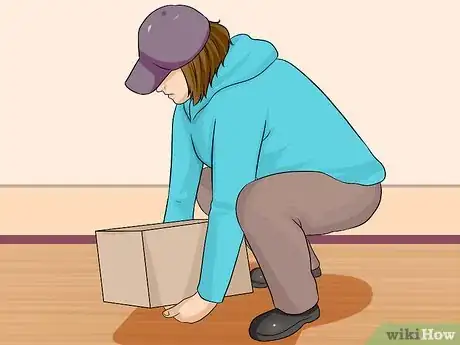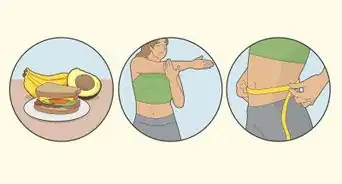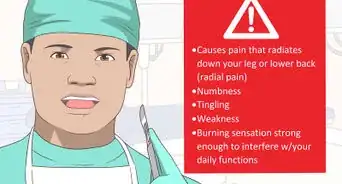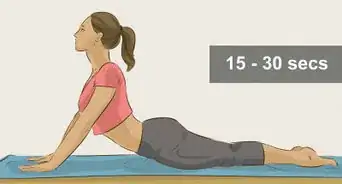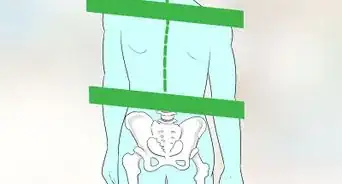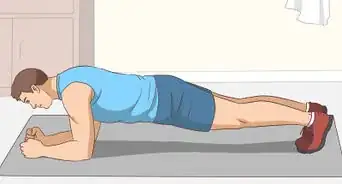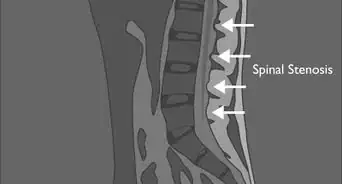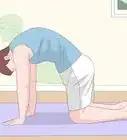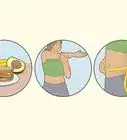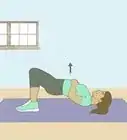This article was medically reviewed by Robert Borer, DC. Dr. Borer is a Chiropractor in Michigan, where he operates a family-owned chiropractic business with his wife, Dr. Sherri Borer. He received his Doctorate of Chiropractic Medicine from Palmer College in Iowa in 1999. His practice was a winner of the 2015 Patients' Choice Awards in Saline, Michigan.
There are 18 references cited in this article, which can be found at the bottom of the page.
This article has been viewed 428,347 times.
A curved or hunched back can cause painful problems that will get worse over time. Doing your best to keep your back straight will help mitigate worsening symptoms as you get older.
Steps
Recognizing Signs of Bad Posture
-
1Know what good posture looks like. The first step to improving your posture is simply knowing what to look for in yourself. Make sure your shoulders are back, your stomach is in, and your chest is out. Stand sideways in a mirror and see if you can draw a straight line from your earlobe down through your shoulder, hip, knee, and ending at the middle of your ankle.
- Head and neck: Make sure that your head extends straight up from your shoulders. Many people tend to lean their head forward. If your ears line up with the front of your chest, you need to pull your head back.[1]
- Shoulders, arms, and hands: Your arms and hands should fall on the side of your body. If so, your shoulders are exhibiting good posture. If your arms fall towards the front of your chest, then pull your shoulders back.[2]
- Hips: Find a happy middle position between rolling your hips far forward or backward.[3]
-
2Recognize pain and discomfort. The most obvious sign of bad posture is back, shoulder, and neck pain. Poor posture causes your chest muscles to tighten, which forces your upper back muscles to compensate. This results in weaker back muscles in general, which produces pain and discomfort. Since all of your muscles work together, when one muscle set isn't functioning properly, the others are affected.[4]
- Not all people with poor posture feel pain or discomfort. Our bodies are fairly capable of adjusting and compensating.
Advertisement -
3See if you have “over-pronated” feet. This is when the arch of your foot is almost completely flat. It is also often called a “fallen arch”. Our feet are the lowest balancing mechanism of our bodies. If you have poor posture, you are forcing your feet to work harder to maintain balance. This causes your feet to gradually “flatten” so as to provide a sturdier foundation. If you improve your posture, your weight should rest nearly entirely on top of your heels, freeing up the remainder of your foot to have an arch.[5]
- While “fallen arches” are themselves a sign of poor posture, you may also experience pain in your feet, ankle, calf, knee, hip, and lower leg area in general.[6]
-
4Evaluate your mood. A study conducted at San Francisco State University asked students to walk down a hall in a slouched position or to stand upright and skip. The slouchers reported increased feelings of depression and general lethargy. While this may seem strange, think about it. Your body language often indicates your mood in general.You sit crouched in a corner with your arms crossed when you are angry or sad. You perk up when you are happy. So why can't your moods tell you something about your body posture? If you've been down in the dumps, consider improving your posture.[7]
Improve your Posture
-
1Remind yourself to stand up straight. Set your phone or computer to alert you to check your posture. Place notes for yourself around your house, car, and office. Sometimes all it takes to keep good posture is constant reminders and reinforcement. You need to reprogram your habits just as much as you need to strengthen your back muscles.[8]
-
2Practice Yoga. Yoga is specifically good for improving your posture. Some of the best exercises include:
- The cobra. Lie on your stomach with your hands under your shoulders. Make sure you point your fingers forward. Then, keeping your elbows close to your sides, try to touch your shoulder blades together. Be sure to stabilize your back by tightening your abdominal muscles. Then, slowly lift your chest to the ceiling, making sure to keep your neck long. Use your arms for support, but your back muscles to pull you up. Hold for 10 breaths, then lower yourself. Repeat 3 times. [9]
- Child's pose: Stand on your knees with your arms above your head. Palms should be facing each other. Then, exhale and slowly move forward. Lower your forehead to the floor and stretch your arms out in front of you, pressing your palms into the floor. Hold, and then return to the starting position. Repeat six times. [10]
- Mountain Pose. Stand straight with your feet on the ground, heels slightly apart. Be sure your weight is evenly distributed between your two feet. Lift the insides of your ankles so that your feet seem cupped. Then, extend your shoulder blades and try to touch them. Slowly release. Finally, raise your arms to the ceiling and gaze forward.[11]
-
3Do other exercises and stretches to improve your posture. These techniques should specifically focus on your abdominal and back muscles as these are the muscles that will help support your spine. [12]
- Squeeze your shoulder blades together. Pretend you're holding a ball between your shoulder blades.Try to squeeze the ball by bringing your shoulder blades together. Hold for 10 seconds. This will help stretch the front of your shoulders, which will likely be tight from poor posture.
- Roll your shoulders. Roll one shoulder forwards, upwards, backwards, then back down. Imagine that you are sliding your shoulder blade down your spine. Then, repeat on the other side. This will help settle your shoulders farther back than they usually settle.
- Stretch your chest. Find a rolled up towel or piece of fabric and stand with your legs shoulder width apart. Grip the fabric so that it is taut and your hands are also shoulder width apart. Inhale and lift your arms to shoulder height. Then, exhale and pull your arms up and back as far as you can. Hold for two inhales and exhales, then lower your arms and repeat.[13]
Make Adjustments in your Daily Life
-
1Choose an appropriate bag. Choose a purse, book bag, or backpack that will help evenly distribute weight throughout your back. Choose something that has broad, padded straps that can be positioned on both shoulders. [14]
-
2Choose supportive shoes. Consistently wearing high heels or flimsy slip ons will put extra strain on your back. Look for shoes with a supportive sole, square toes, and a less than one inch heel. Larger heels force more of your weight forward, which will encourage you to slouch or to overcorrect, which is equally bad for your back.[15]
-
3Learn how to sit at your desk. Your feet should touch the floor, your back should be straight, and your neck should be in a neutral position. This will help alleviate back pain as well as straighten your back. You can also buy ergonomic chairs that will encourage you to sit up straight in order to be comfortable. [16]
-
4Adjust your sleeping habits. Consider sleeping on your side, with your hips flexed about 30˚. Bend your knees at about 30˚ as well. Finally, move your neck slightly forward on the pillow to help elongate your spine.
- If you sleep on your back, consider putting a pillow under your knees and a rolled towel under your back. This will help relieve pressure on the back, alleviating back pain and encouraging back lengthening.
- If you sleep on your side, consider putting a pillow in between your knees to help keep your hips aligned.
- Avoid sleeping on your stomach. Sleeping face down puts unnecessary strain on the spine, and can lead to spinal degradation. It can also lead to chronic neck pain and lower back pain in the future.
-
5Practice proper lifting techniques. Lifting and carrying heavy objects incorrectly can lead to serious back pain. If you consistently do lots of heavy lifting, consider wearing a back support belt, which will help you maintain good posture while lifting. In addition, be sure to maintain proper form:
- Bend at the knees, not the waist. Your leg and stomach muscles are designed to help you carry and lift things, but your back muscles are not. When you go to lift something, be sure to bend completely at the knees instead of bending over to avoid straining your lower back.
- Keep the objects close to your chest. The closer the object is to your chest, the less work your back will have to do to hold it up.
Seeing a Professional
-
1Visit your doctor. If you have a severely curved back or spine and you find it difficult to stand up straight, consider talking to your doctor. You may have scoliosis or a number of other spinal-related issues.Your doctor may ask you to wear a back brace. Only in the most extreme cases will the doctor recommend spinal surgery. There are many other methods of improving back pain.[17]
-
2See an egoscue practitioner. Egoscue professionals specialize in posture therapy. they will focus on your symptoms (if any), your posture, your gait, and a range of other issues. They'll teach you how to stretch your back — focusing on your problem areas. They'll then create an exercise and stretching regiment that you can do at home.[18]
- Most of these exercises will be geared towards increasing your range of motion in your hips and elongating your spine, releasing any tension compacted along your spinal column.[19]
- If your problem is less severe, consider just working with a personal trainer. Tell your trainer that you want to focus on those muscles that lead to better posture (primarily your lateral muscles). They'll show you sets of general exercises and stretches to improve your posture.[20]
-
3Consult a chiropractor. They'll take a series of x-ray images of your back and spine. Afterwards, they'll be able to measure the exact curvature of your spine to indicate if you have a serious issue. Your chiropractor may also be able to examine your individual vertebrae for malformations, slips, or misalignments. Many of these issues can be treated in office, but if your chiropractor discovers a more serious issue, they'll refer to you a specialist.[21]
-
4Get regular massages. Stress and constant tension can lead to tight back muscles, and therefore a hunched back. If you lead a stressful life, consider working regular massages into your daily life.[22]
- Alternatively, sitting in a massage chair regularly will relieve stress, but it won't be able to give you the specialized tension in those areas that require it most like a trained masseuse would be able to do.
References
- ↑ http://www.builtlean.com/2015/02/18/improve-posture-tip/
- ↑ http://www.builtlean.com/2015/02/18/improve-posture-tip/
- ↑ http://www.builtlean.com/2015/02/18/improve-posture-tip/
- ↑ http://www.thehealthsite.com/diseases-conditions/top-5-bad-postures-that-can-affect-your-health/
- ↑ http://www.thehealthsite.com/diseases-conditions/top-5-bad-postures-that-can-affect-your-health/
- ↑ http://www.medicalnewstoday.com/articles/168608.php
- ↑ http://www.prevention.com/health/healthy-living/how-bad-posture-affects-your-health-and-happiness/1-deepens-depression
- ↑ http://www.spine-health.com/wellness/ergonomics/ten-tips-improving-posture-and-ergonomics
- ↑ http://www.health.com/health/article/0,,20411585,00.html
- ↑ http://www.womenshealthmag.com/yoga/yoga-for-better-posture?page=2
- ↑ http://breakingmuscle.com/yoga/6-yoga-poses-for-better-posture
- ↑ http://articles.chicagotribune.com/2011-09-13/health/sc-health-0921-fitness-posture-20110913_1_poor-posture-neck-pain-shoulder
- ↑ http://articles.chicagotribune.com/2011-09-13/health/sc-health-0921-fitness-posture-20110913_1_poor-posture-neck-pain-shoulder
- ↑ http://www.spine-health.com/wellness/exercise/getting-started-straighten-10-healthy-lifestyle-recommendations
- ↑ http://www.spine-health.com/blog/five-ways-keep-your-spine-healthy-and-happy
- ↑ http://www.spine-health.com/wellness/ergonomics/ergonomics-office-and-workplace-overview
- ↑ https://www.srs.org/patients-and-families/common-questions-and-glossary/frequently-asked-questions/treatment-and-coping
- ↑ http://www.egoscue.com/
- ↑ http://www.scoliosis.org/resources/medicalupdates/exerciseadults.php
- ↑ http://www.stretchify.com/scoliosis-stretches/
- ↑ http://www.chiro.org/research/ABSTRACTS/Spinal_Allignment.shtml
- ↑ http://www.massageenvy.com/benefits-of-massage-therapy/improves-posture.aspx
About This Article
To straighten your back, set alarms on your phone to frequently remind you to sit up straight so you change your habits faster. If you’re sitting at a desk, that means you should have your feet flat on the ground, your back straight, and your neck in a neutral position. At night, you can also try to sleep on your side with your hips flexed up about 30°, your knees flexed down, and your neck forward. This will help lengthen your spine and relieve pain. Keep reading for advice from our Chiropractor reviewer on recognizing bad posture and fixing it with exercises.
